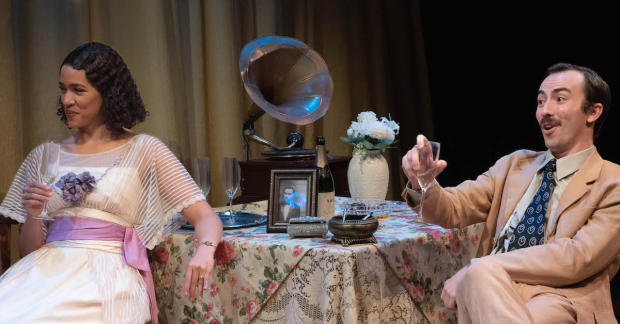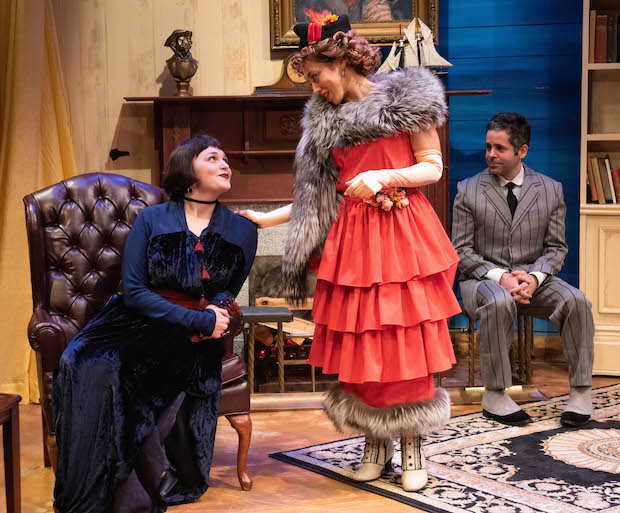
Sheila Brandreth (Sarin Monae West) and Keld Maxwell (James Evans) toast to their upcoming marriage in Mint production of Noël Coward’s The Rat Trap (photo © Todd Cerveris)
THE RAT TRAP
New York City Center Stage II
131 West 55th St. between Sixth & Seventh Aves.
Tuesday – Sunday through December 10, $45-$90
minttheater.org
nycitycenter.org
There’s a reason why Noël Coward’s first “serious play,” The Rat Trap, has never before been performed in the United States: It’s not all that good. In fact, not even the Mint, the finest purveyors of lost and forgotten theater, can save the drawing-room comedy of manners in its sharp production running at City Center’s Stage II through December 10.
“For years I have mourned the fact that The Rat Trap never saw the light of day,” Coward wrote in 1924’s Three Plays, consisting of The Rat Trap and the more successful Fallen Angels and The Vortex. “But now the time for it is past, the sterling merits I saw in it when it was first written in 1920 have faded.” Coward wrote the play when he was eighteen, reportedly for Meggie Albanesi, who died in December 1923 from the aftereffects of a botched abortion.
Coward didn’t attend the play’s 1926 debut in London; he wrote in his 1937 autobiography, Present Indicative, “In spite of the effulgence of the cast, the play fizzled out at the end of its regulation two weeks. I was not particularly depressed about this; The Rat Trap was a dead love.” He particularly called out the big scene in the last act, which “made me shudder, nostalgically, but with definite embarrassment. It was neither good enough nor bad enough to merit a West-End run, and it was perhaps a mistake to have allowed it to be produced at all; however no harm was done, and I am sure that it was admirable exercise for the actors.”
It is indeed admirable exercise for the splendid Mint actors and director Alexander Lass, but the story grows quickly tedious. It begins in Olive Lloyd-Kennedy’s (Elisabeth Gray) apartment in West Kensington, where she lives with young writer Sheila Brandreth (Sarin Monae West), who is about to marry burgeoning playwright Keld Maxwell (James Evans). Olive is not a fan of the wedding ritual; she tells Sheila and Keld, “Marriage nowadays is nothing but a temporary refuge for those who are uncomfortable at home.”
Olive has invited over another couple, the decadent author Naomi Frith-Bassington (Heloise Lowenthal) and the would-be poet Edmund Crowe (Ramzi Khalaf), Bohemian lovers who refuse to get married because that would be too conventional. “Miss Brandreth, how courageous it is of you to marry! I should never dare,” Naomi says. “Edmund and I realise the value of love, perhaps better than anyone; it seems sacrilege to fetter it down with chains of matrimony.”

Naomi (Heloise Lowenthal) and Ruby (Claire Saunders) share a moment as Edmund (Ramzi Khalaf) looks on in The Rat Trap (photo © Todd Cerveris)
Six months after their marriage, Sheila and Keld are living in their house in Belgravia, she working on her next book in her bedroom, he on his play in the far more comfortable study. There are already signs of strain as they argue over a pencil and the value of their ornery maid, Burrage (Cynthia Mace). Sheila tells Keld, “I mean to discover what the trouble is; it’s getting on my nerves terribly, so it is on yours. We’re not being happy together, Keld, we’re not being happy together. Don’t you realise it — isn’t it awful?” He unconvincingly tries to push it aside and declare it’s all “trivialities,” but when his play is an instant hit and he is spending more time with one of the stars, the ambitious ingénue Ruby Raymond (Claire Saunders), trouble is not far off.
The Rat Trap is impeccably rendered by director Alexander Lass (in his New York debut) on Vicki Davis’s ever-changing set, as stagehands move around furniture between scenes and a yellow semicircular curtain occasionally opens in the back to introduce a larger space. Hunter Kaczorowski’s period costumes capture the era, and the lighting, by Christian DeAngelis, and the sound, by Bill Toles, are meticulous and precise, as always with the Mint. And the cast is excellent, particularly West (The Skin of Our Teeth, Merry Wives) as Sheila, her initially dreamy eyes turning sour over time; Khalaf as Edmund, who makes what he believes to be profound statements that get no reaction from the others; and Mace as Burrage, whose displeasure with her life is apparent in her every word and move.
The problem is that The Rat Trap is very much an early play by a writer still sowing his oats; Coward would go on to pen Private Lives, Cavalcade, Design for Living, Present Laughter, and Blithe Spirit, all within a spectacular twelve-year span from 1929 to 1941. While impressive for a teenager, The Rat Trap ultimately falls apart as Coward drifts into melodrama with soap-opera twists and turns. A late revelation actually made my jaw drop and my face wince.
Sharing yet another rave review of his aptly titled play Stress, Coward’s protagonist Keld, a kind of stand-in for the author himself, reads: “‘There was none of that forced appreciation one generally sees at first nights nowadays; the debonair author made a witty speech in response to the ecstatic calls for him. He should indeed be proud of a really great achievement. . . .” In this case, Coward’s own really great achievements lay in the future, with at least one clunker to help pave the way.